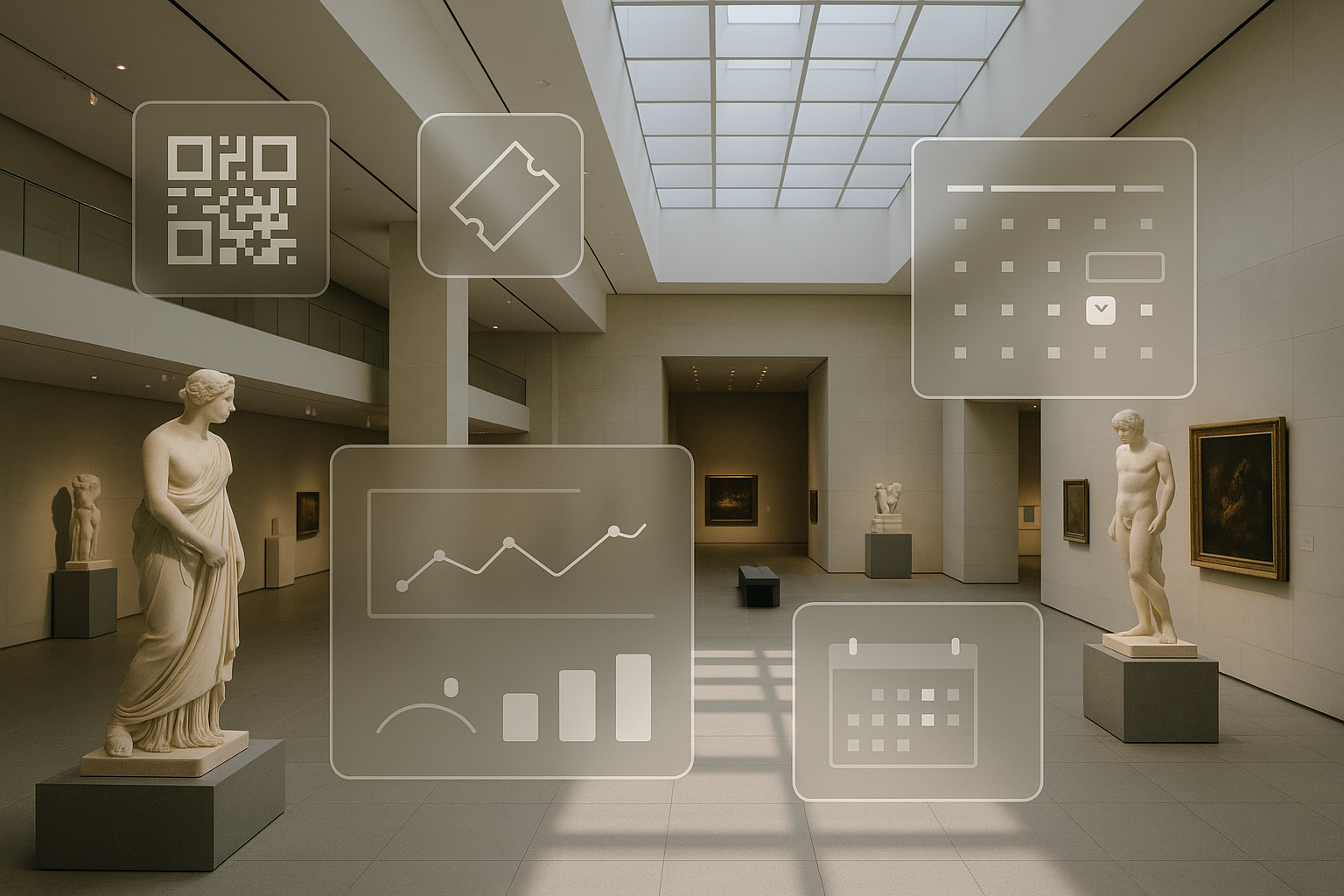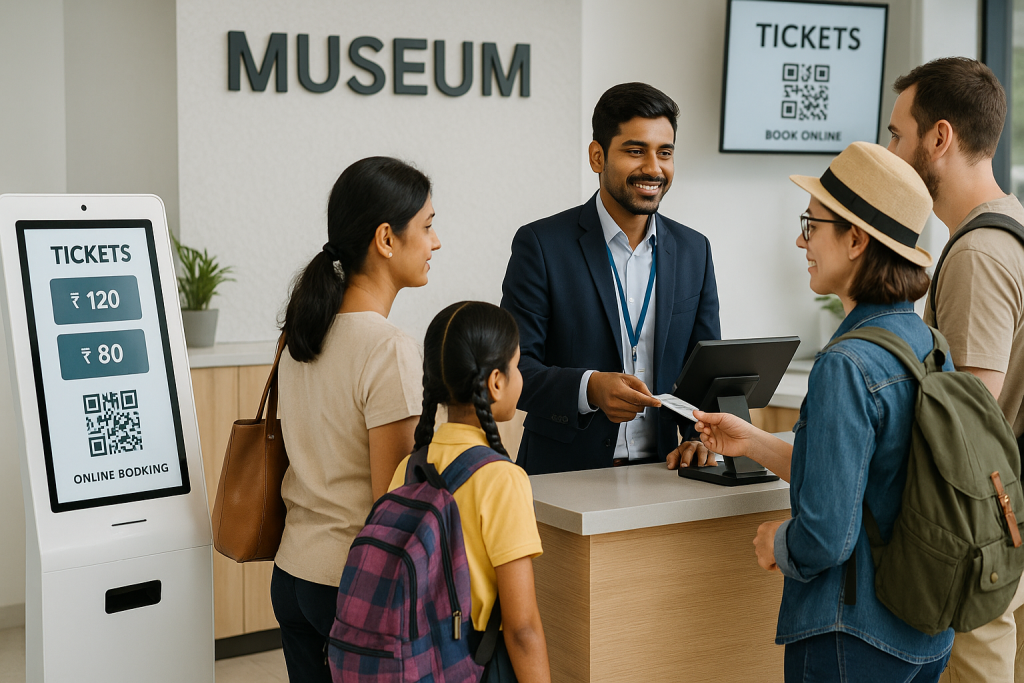Let’s be honest — your museum ticket software setup might be… kinda everywhere.
You’ve got an offline counter running one system. Your weekend online bookings? Managed through a third-party tool. Special exhibitions? Google Sheets. Maybe an old POS machine still beeping in the back office. Sounds familiar?
Now imagine this:
- One dashboard showing all ticket sales — live.
- Real-time data on who walked in, how they booked, and what event they attended.
- No back-and-forth between five platforms just to get your weekly report.
That’s what museum ticket software with an integrated system does. It brings it all together — your visitor data, ticketing workflows, and booking channels into one clean, central hub.
No more hunting for spreadsheets. No more last-minute calls to reconcile bookings before your director’s report.
Benefit?
- Less manual work
- Fewer errors
- More time to focus on improving visitor experiences (instead of playing IT support)
If your museum already has ticketing tools but they don’t speak to each other — it’s not your fault. You were patching together solutions.
Now, it’s time to evolve.
One platform. One view. Real control.
1. Meet Visitor Expectations with Frictionless Online Booking
Let’s talk about your visitors.
They’re not standing in line on a humid afternoon waiting to buy a paper ticket. They’re online. On their phone. Scrolling your Instagram. Seeing a story about an exhibition. And boom — they want to book.
If your online museum ticket sales process is slow, clunky, or redirects them to a weird third-party site with 2000s UX…you’ve already lost them.
Here’s what today’s visitor expects:
- Book in 30 seconds, max
- Choose a time slot, pay online, get an e-ticket
- Bonus: No need to print anything or dig through inboxes
And here’s what you get with a proper museum booking platform:
- Branded, mobile-friendly ticketing experience
- Flexible time-slot management
- Instant confirmations, calendar syncs, auto-reminders
You’re not just selling tickets. You’re setting the tone for their entire visit. If booking is smooth, they walk in happier. If it’s messy? Their day starts with friction.
In short:
Your ticketing UX is now part of your exhibition. Make it count.
Because that first click → to payment → to entry — it should feel like magic. And the right museum ticket software can do that for you.
2. Get Full Control Over Visitor Flow and Profiles
Okay, here’s the thing nobody tells you:
Your visitor data is more powerful than your ticket sales.
But if you’re still relying on counters, logbooks, or random QR scans with no unified backend… you’re basically flying blind.
Let’s fix that.
Modern museum visitor management systems don’t just let people in — they tell you who’s coming, when, how often, and why.
They’re not just access tools — they’re insight engines.
With the right museum ticket management software, you can:
- Track peak hours and manage crowd flow
- Spot loyal members vs. first-timers
- Tag school groups, VIPs, guided tours — all in one place
- Even set capacity limits per gallery or floor (so no one gets squished)
And no, this isn’t overkill.
This is the foundation for a better experience for your staff and your visitors.
Because here’s the truth:
You can’t improve what you can’t see. And visibility starts with good data.
When your system is fragmented, you miss patterns. You lose touch with real behavior. But when it’s all connected visitor profiles, ticket types, entry timing, you start operating like a 21st-century museum.
Less chaos. More clarity.
That’s the real value of centralized museum visitor management.
3. Make Strategic Decisions Backed by Visitor Analytics
Let’s say your weekend numbers dropped by 22%.
Now what?
If you’re guessing, “maybe weather?” or “we didn’t promote enough?”, you’re missing the real opportunity.
Good decisions aren’t made in the dark.
They’re made with data.
Modern museum ticket software doesn’t just sell tickets , it collects insights. Like:
- Which exhibitions drive the most traffic
- What ticket types convert best online
- Which days see peak vs. low footfall
- How many visitors are returning vs. one-time
Imagine logging into your dashboard and seeing:
- Graphs of daily vs. weekly visits
- Demographics of your audience
- Funnel data from landing page to ticket purchase
You’ll know what’s working and what’s not.
You’ll stop relying on assumptions and start planning with precision.
Need to justify funding for a new exhibit?
Need to show impact to your board or donors?
This is your ammo.
And the beauty? You don’t need a data analyst.
The best museum ticket sales software turns complex stats into clean visuals and exportable reports.
Because in 2025, running a museum is part curation, part optimization.
And the right system helps you do both beautifully.
4. Customize Ticketing for Every Exhibit and Experience
Not all tickets are created equal.
A weekend pass to your permanent collection isn’t the same as entry to a limited-time Van Gogh VR experience and your system needs to get that.
Here’s where most museums struggle:
You launch a special exhibit… and suddenly you’re juggling new time slots, separate ticket prices, manual approvals, maybe even Excel sheets. Chaos.
With modern museum ticketing software, especially platforms built for museum exhibition ticketing, this becomes easy.
You can:
- Create exhibit-specific ticket types (VIP, timed, member-only)
- Set different pricing tiers for peak vs. off-peak
- Limit quantities for high-demand slots
- Bundle experiences (like a ticket + audio guide + gift shop discount)
Everything is customizable.
No more bolting on temporary fixes or hacking your system just to run one event.
And the best part?
Your team gets flexibility without losing control.
Your visitors get clarity without confusion.
Because when an exhibit goes live, your ticketing shouldn’t be the bottleneck, it should be the launchpad.
So next time you’re planning something big, make sure your museum ticket management software is built to handle it and then some.
5. Free Up Staff Time with Smart Ticketing Workflows
Let’s be real:
Your team didn’t sign up to spend hours reconciling Excel sheets, manually sending confirmation emails, or double-checking access at the door.
But that’s exactly what happens when your systems aren’t built for automation.
It’s a time drain. It’s frustrating. And it’s completely avoidable.
Here’s where great digital ticketing for museums steps inand quietly saves the day.
With smart automation, you can:
- Auto-generate e-tickets with QR codes
- Send confirmation and reminder emails (no follow-ups needed)
- Trigger post-visit feedback surveys
- Instantly update availability when time slots fill
- Generate daily sales and attendance reports without lifting a finger
The right museum ticketing system does the work for you in the background.
No more manual cross-checking. No more bottlenecks at entry.
Just clean workflows that run on autopilot.
The real win?
Your team finally has time to focus on the human stuff like enhancing the visitor experience, improving exhibitions, or, you know, actually managing the museum.
Automation isn’t just a tech upgrade.
It’s a mindset shift from firefighting to future-ready.
Ready to Bring Museum ticket software for Your Museum?
If your current system is holding you back — disconnected, clunky, or too manual — it’s time to see what modern looks like.
EveryTicket is built for museums that want to grow smarter:
- Centralized ticketing
- Automated workflows
- Real-time visitor insights
- Secure digital entry
Want to see it in action?
Fill the inquiry form to book a free demo with our team — and let’s upgrade your ticketing experience together.



